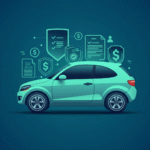Vehicle insurance isn’t just a bureaucratic requirement; it’s a safety net that protects both you and others on the road. While the legal necessity of having some form of car insurance is well-known, understanding the different types available—and their unique benefits—can make all the difference in ensuring you’re adequately covered.
From liability insurance to more specific options like gap insurance, each policy type is designed to address particular risks and situations. This guide will provide an overview of the main types of vehicle insurance, when each is most useful, and practical tips for crafting a policy that meets your needs and budget.
What Is Vehicle Insurance and Why Is It Important?
Vehicle insurance is a contract between a driver and an insurer in which the insurer agrees to cover financial losses associated with car-related risks, in exchange for premium payments. These risks can range from accidents and theft to liability for property damage or injuries caused by the insured driver.
Why You Need Vehicle Insurance
- Legal Requirement
Most states mandate that drivers maintain a minimum level of vehicle insurance. Failing to meet this requirement can lead to legal penalties, fines, or even suspension of your driver’s license.
- Financial Security
Accidents can be costly. They involve repair bills, medical expenses, and potential legal fees. Vehicle insurance ensures these costs are covered, offering you peace of mind and financial stability.
- Protecting Your Assets
If you’re found at fault in an accident, liability insurance can prevent you from having to pay damages out-of-pocket, safeguarding your savings and property.
- Reducing Stress
Knowing you’re insured allows you to focus on driving without worrying excessively about the “what-ifs.”
Types of Vehicle Insurance
When exploring vehicle insurance, you’ll find several distinct types of coverage to suit different situations. Below, we detail the six main types and explain when each might be most beneficial.
1. Liability Insurance
Liability insurance is the foundation of most vehicle insurance policies and is legally required in most states. It protects you from the financial repercussions of causing an accident.
What It Covers
- Bodily Injury Liability: Covers medical expenses and loss of income for the other party.
- Property Damage Liability: Covers the cost of repairs to the other driver’s car or other damaged property, like fences or buildings.
When It’s Most Useful
If you’re at fault in an accident, liability insurance ensures the other party’s expenses are covered. This policy doesn’t cover your car or injuries, but it protects you from lawsuits or financial ruin.
2. Collision Insurance
Collision insurance covers damage to your own vehicle, regardless of who caused the accident.
What It Covers
- Repairs to your car resulting from a collision with another vehicle or object (e.g., a tree or guardrail).
- Replacement of your vehicle if it is deemed a total loss.
When It’s Most Useful
Collision insurance is a must-have for new or highly valuable vehicles. It’s often required if you’re leasing or financing your car.
3. Comprehensive Insurance
Comprehensive insurance covers non-collision events that can damage or destroy your car.
What It Covers
- Natural disaster damage (e.g., floods, fires, storms).
- Vandalism and theft.
- Damage caused by falling objects or animals.
When It’s Most Useful
If you live in an area prone to natural disasters, vandalism, or high rates of car theft, comprehensive insurance provides peace of mind. It’s especially important for owners of expensive or new vehicles.
4. Uninsured/Underinsured Motorist Coverage
This coverage protects you if you’re hit by a driver who doesn’t have insurance or lacks enough coverage to pay for your damages.
What It Covers
- Medical expenses.
- Car repair or replacement costs.
- Lost wages if you’re unable to work due to injuries.
When It’s Most Useful
This type of insurance is crucial in areas with high rates of uninsured drivers. It ensures you won’t bear the financial burden of another driver’s negligence.
5. Personal Injury Protection (PIP)
Personal injury protection, also known as no-fault insurance, ensures coverage for medical expenses and sometimes lost income, irrespective of fault.
What It Covers
- Hospital bills resulting from an accident.
- Rehabilitation costs.
- Lost wages or funeral expenses.
When It’s Most Useful
Drivers in no-fault states are often required to carry PIP. Even in other states, it can be valuable if you have limited health insurance coverage.
6. Gap Insurance
Gap insurance protects you when your car is totaled, but its actual cash value is less than what you still owe on your loan or lease.
What It Covers
- The difference between your car’s market value and the outstanding loan or lease balance.
When It’s Most Useful
This insurance is essential for anyone financing or leasing a vehicle. Since new cars lose value quickly, gap insurance ensures you’re not stuck paying for a car you no longer own.
Choosing the Right Combination of Insurance
Selecting the right types of coverage can feel overwhelming. Here are key factors to consider:
- Vehicle Value
What you drive plays a huge role in determining your insurance needs. Expensive or new cars call for full protection (comprehensive and collision coverage), while an older car may only need liability coverage.
- Driving Habits
The amount you drive and the areas you frequent also impact your risk. High-mileage drivers or those commuting in busy urban areas may need more coverage.
- Personal Finances
How much can you afford to pay out-of-pocket for repairs or damages? If funds are limited, increasing your insurance coverage is a smart choice.
- Legal Requirements
Ensure you meet your state’s mandated coverage minimums. Then, consider individual circumstances to determine whether additional coverage is worth the cost.
Tips to Save Money While Staying Covered
Vehicle insurance doesn’t have to drain your finances if you take the right steps. Here are proven ways to cut costs without compromising on coverage:
1. Shop Around for Quotes
Compare rates from multiple providers to find the best deal. Online tools and insurance brokers can simplify this process.
2. Bundle Policies
Many insurers offer discounts when you bundle auto insurance with home or renters insurance.
3. Choose a Higher Deductible
Opting for a higher deductible often lowers your premium. Just ensure you have enough savings to cover the deductible if needed.
4. Take Advantage of Discounts
Ask your provider about potential discounts for:
- Safe driving records.
- Taking defensive driving courses.
- Installing anti-theft devices.
5. Review Your Policy Annually
Evaluate your insurance needs regularly, especially if your car’s value has declined or your driving habits have changed.
6. Maintain a Clean Driving Record
Safe driving not only protects you physically but also keeps your rates lower by avoiding accidents and violations.
Final Thoughts
The right vehicle insurance provides peace of mind and financial protection when you need it most. From the essential liability coverage to additional options like gap or comprehensive insurance, each type serves a specific purpose. By understanding your needs and carefully evaluating your options, you can craft a policy that fits both your driving habits and budget.
Take your time to research policies, compare quotes, and don’t hesitate to consult with an insurance advisor. Investing in the appropriate coverage today ensures that you’re prepared for the uncertainties of tomorrow.




